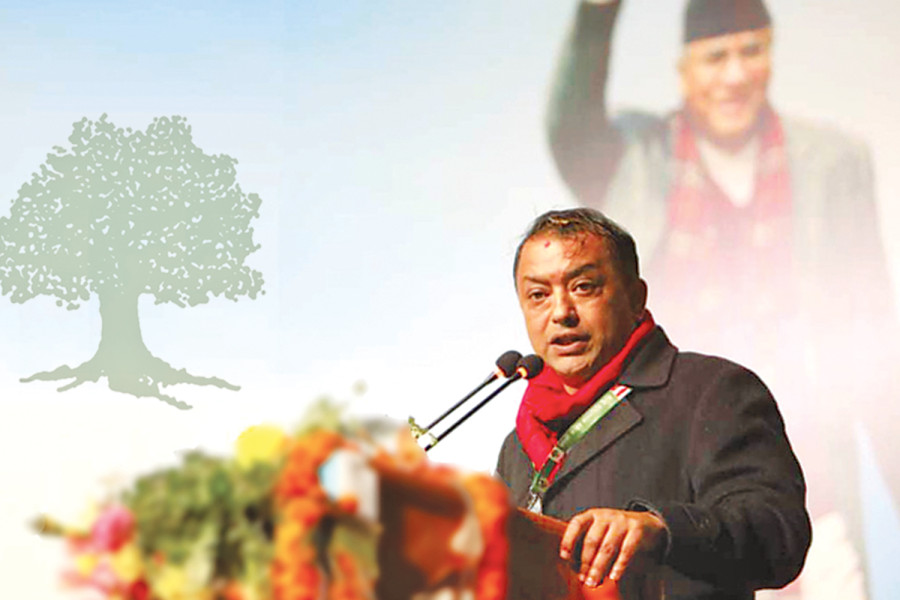Columns
Gagan’s crusade against coalition culture
He may be blamed for triggering the collapse of the Congress-Maoist alliance, but he needn't worry.
Mohan Guragain
Gagan Thapa may have won several positions in the Nepali Congress, including general secretary, ever since the firebrand student leader made forays into party politics after the 2006 Movement. However, his most significant ideological victory came during the Mahasamiti meeting that concluded last month. He helped create a general perception that electoral alliances had done the party no good. His proposal that the Congress shouldn’t forge alliances with major competitors in the next election was passed by the plenum, a body second only to the general convention. It was not immediately known how seriously the party or its top brass took the document that was yet to be fully endorsed, but the immediate repercussions were seen in the governing Congress-Maoist alliance.
Prime Minister Pushpa Kamal Dahal’s Maoist Centre chiefly blamed Thapa’s political line—apart from the demand for Hindu statehood that some Congress leaders are openly promoting—for his decision to ditch the Congress as a ruling ally and to take the CPN-UML on board. This has left the Congress party reeling, but Thapa seems undeterred.
This episode has made the influential leader more prominent when the Congress is at one of its biggest junctures in history. Party president Sher Bahadur Deuba is in his late 70s with no clear successor. Three prominent Koirala leaders—Shekhar, Shashank and Sujata—from the clan that established and led the Congress for much of its history of over seven decades are divided. Shekhar Koirala, who challenged Deuba’s presidency, is not vocal about his take on the current developments. He stood against his party supporting Dahal’s prime ministership and fielded a rebel candidate to lead the Koshi provincial government in collusion with the UML. For this, he drew the ire of Dahal, who blamed factional politics in the Congress for the failure of the alliance.
Much of the Congress senior leadership is discredited, too, which Thapa knows well. Many Congress leaders have been named in corruption cases, and some others have lost moral authority, to say the least. Among the new breed of leaders, Thapa’s position looks unchallenged. He hasn’t been tested much—barring his brief and successful stint as health minister. Having challenged Deuba for the Congress parliamentary party leader position, Thapa has made his aspirations clear. The Nepali communists’ policy of giving leadership to the one who sets the party ideology merits broad acceptance. Even by that standard (Congress claims a higher democratic ground), Thapa’s bid for the party presidency is valid.
The Congress’ political turf is encroached upon by multiple communist forces and the emerging Rastriya Swatantra Party of more ideologically neutral youths. Thapa argues that making the Maoist party one of its political allies erodes the Congress party’s principles that the cadre has known since the time of the charismatic leader BP Koirala.
Electoral symbols in Nepal have come to be established as the party’s visual representation among the people. The “tree” is now easily identifiable like the four stars in white against a red rectangle as a Congress symbol. Thapa argued, like many of his party colleagues, that hardened Congress supporters who religiously voted for “tree” all these years found it taboo to put the stamp on another symbol, such as the Maoists’ “hammer and sickle in a circle” and the CPN (Unified Socialist)’s “pen”.
As Nepal’s traditional parties lose popular base election after election, they look increasingly desperate for poll tie-ups not only to secure their seats but also to block a major rival force from outperforming them. In a triangular dilemma between the Congress, the UML and the Maoist Centre, the Maoists have consistently played one giant party against the other. While their tie-up with one prevents the other from doing (too) well in the elections, the Maoists’ strength has also been diminishing gradually since their first election in 2008, having just emerged from a devastating insurgency. The current equation in Nepal’s federal parliament is that no party has a clear majority, and political combinations favour smaller parties more than the bigger forces. As a result, in the 15 months since the first government was formed after the November 2022 elections, three coalitions have been set up without the two biggest parties leading any. Dahal’s Maoist Party is steering the government.
This scenario may have frustrated the leaders of the two top parties. If no two of the three largest parties sought alliances between them, voters could be more ideologically aligned. The Congress-Maoist alliance involving smaller forces went to polls on a plank weakened by their clashing political views. They had banded together only to defeat KP Sharma Oli and his UML party, portraying him as someone keen to weaken state institutions. That it was driven only by the motive of grabbing a bigger electoral pie was evident when the alliance’s unity faltered after the results were out. The UML readily fed Dahal’s aspirations by making him, the leader of the third largest party, the prime minister.
This way of going to the polls has disillusioned the voters. As parties look bereft of principled agenda to drive the nation forward, their underlying goal of grabbing state resources through corrupt means and remaining in power to protect such criminals is exposed. If only for being left out to fight the elections majorly on its own, the UML challenged the Congress to go to the polls independently. The party argues that if the two biggest parties, one leading the democratic bloc and the other the communist front, go to the polls as main rivals, there would ultimately be polarisation along their ideological lines. This ideal two-party polarisation would give one of them the majority, with or without the direct support of fringe forces, to govern, while the other would remain in the opposition and await its chances.
If Thapa of the Congress buys this argument and puts it into practice, politics could be less messy. A typical case of rot in current politics is the courting of Madhav Kumar Nepal of the Unified Socialist, a splinter of the UML produced by the impact of an ego clash between Oli and Dahal when they co-chaired an arbitrarily united communist party for three years.
Madhav Nepal has 10 House of Representatives members from the party that did not get enough nationwide votes to be recognised as a national party. Nepal currently has ministers in federal governments, holds stakes in provincial governments, claims a seat in the upcoming by-elections and aspires to become the prime minister, albeit briefly, before the 2027 general elections. Failing to satisfy him could be costly for the coalition.
There are challenges before Thapa to sustain his movement of rejuvenating the Congress to make it stand on its own ground without leaning on ideologically opposite forces. Many privileged fellow leaders may be cursing him for having triggered (as Dahal blamed) the collapse of the Congress-Maoist alliance and left the party in the cold. A leader of Thapa’s conviction should not be deterred.




 4.91°C Kathmandu
4.91°C Kathmandu















